Food Microbiology Learning outcomes
1/43
There's no tags or description
Looks like no tags are added yet.
Name | Mastery | Learn | Test | Matching | Spaced |
|---|
No study sessions yet.
44 Terms
What is Food Microbiology
Food microbiology is a study of the micro-organisms that cause loss of food quality and safety, as well as those organisms that help to preserve the food and keep other organisms away.
Groups of microorganisms involved in food spoilage and food safety
Viruses
Parasites
Fungi
Bacteria
Viruses
Reproduces in living cells
They need a host (e.g. human body)
A food is not a host → hence viruses don’t multiply in foods
And hence viruses are not involved in spoilage.
1-10 particles can cause disease
70% of the incidents caused by infected employees
Parasites
Also don’t grow in food: because they need a living host
There are two types of parasites
Protozoa
Are unicellular
Sources: water, meat, pets
Worms
Are multicellular
Sources: meat, fish, tape worm, herring worm
Example: Herring worm (a parasite) is killed by being frozen → no herring you eat is fresh, it has always been defrosted.
Fungi types
Unicellular: Yeast
Multicellular: Mold
What are mycelium
the vegetative part of a fungus, consisting of a network of fine white filaments (hyphae).
They are branch like structures
What are hypha
each of the branching filaments that make up the mycelium of a fungus.
Bacteria
>> 1000 species
Classification
Morphology (what do they look like)
Cell membrane
Enzymes (differs per bacteria)
Growth conditions (oxygen, temperature)
Biochemical
Classification of bacteria
Morphology (shape)
Gram staining
Enzyme activity
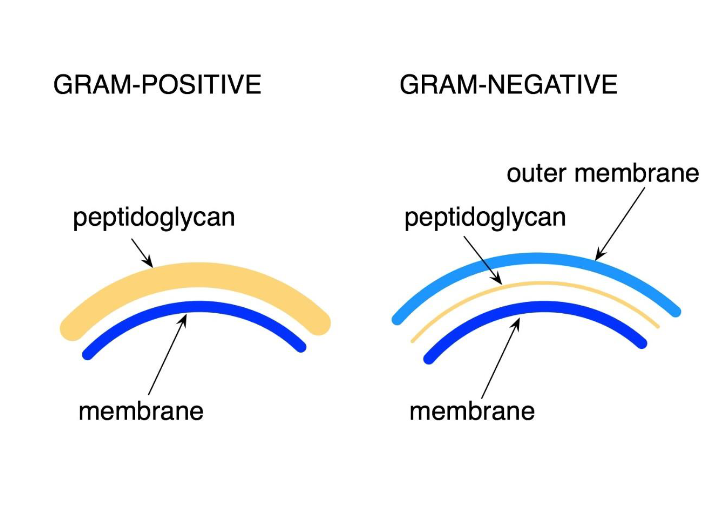
Sources of contamination (primary)
Primary: Raw materials
Soil
Manure
Water
Air
Animals
Slaughter
Sources of contamination (Secondary)
Secondary: Processing and food preparation
Water: process, cleaning
Air: Aerosols, dust
People
Vermin: Rodents, birds, insects
Package
Routing
What is routing?
Routing describes how for example raw materials which are usually contaminated will be located very far from the packaging machine.
Hence there are special routes throughout the factory to prevent contamination.
Factors affecting microbial growth
Product characteristics (intrinsic)
External factors (extrinsic)
Interactions between microorganisms (implicit)
Process factors (heating, cooling, etc.)
Spoilage level
Spoilage level: 107 /ml
Log N/ml = 7
Maximum bacteria concentration
Maximum: 109 / ml
Log N/ml=9
factors affecting microbial growth: Product characteristics (intrinsic)
Structure & nutrients
pH
Aw : Water activity
factors affecting microbial growth: Product characteristics (structure & nutrients)
Cutting a vegetable exposes nutrients. These also become availabel to microorganisms.
Hence microbial growth occurs.
factors affecting microbial growth: Product characteristics (pH)
pH | Range | pHopt |
Bacteria | 4-9 | 6-8 |
Yeast | 1.5-8 | 4.5-6 |
Molds | 1-11 | 3.5-4 |
factors affecting microbial growth: water activity
Measure of the amount of free (or non-chemically bound) water in a product
Where ERH = equilibrium relative humidity
The aw of a food can be measured by putting the food in a container and measuring its ERH.
Know terms not numberss | Minimum aw |
Halophiles (mainly bacteria) | 0.75 |
Xerophiles (mainly bacteria) | 0.60 |
Osmophiles (mainly yeasts) | 0.60 |
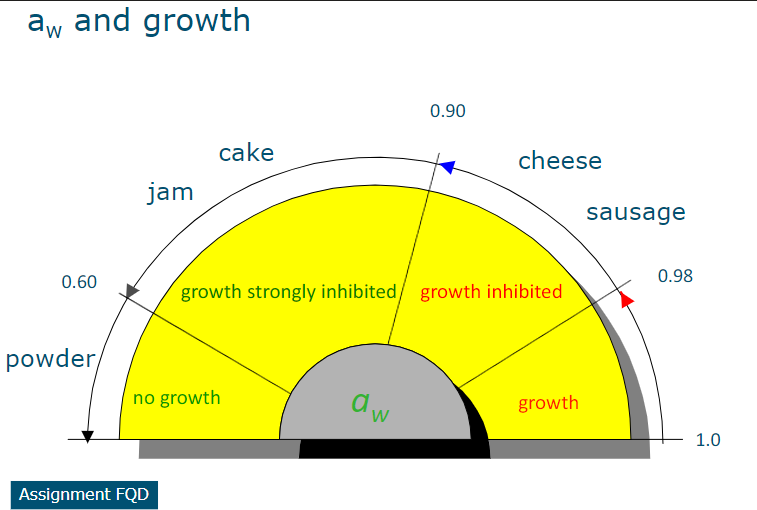
Factors affecting microbial growth: External factors (extrinsic)
Temperature
MAP
Relative humidity
Extrinsic factors to microbial growth - Temperature
<0oC, no microbial growth
0-15oC, refrigerator, start growing
15-35oC, room temp, increases microbial growth rate a lot more than in fridge
35-65oC, microbes start to die
>65oC, inactivation most microorganisms
Extrinsic factors to microbial growth - MAP
Vacuum packaging
Gas packaging
Air replaced with a mixture -> CO2, N2, O2
Composition changes because of product activity
For example normally meat will turn slightly brown, customers don't like this so producers add extra oxygen because it prevents the browning.
Gasses used in MAP
CO2
Very efficient at inhibiting bacterial growth (mainly gram-, molds)
Dissolution in water - carbonic acid
CO2 + H2O -> H2CO3 -> H+ + HCO3-
The acid released also helps to prevent microbial growth
N2
Non inhibitory
O2
Maintains the bright red appearance of meat
Fat oxidation
'Respiring' products: during storage: O2 goes down, CO2 goes up
Packaging without oxygen advantages and disadvantages and hazards
Packaging without oxygen
Advantages
Growth inhibition of aerobes (often spoilage organisms; psychrotrophic Gram-, moulds)
Increase of shelf life
Disadvantages
NO growth inhibition of (facultative) anaerobes (pathogens)
Growth of lactic acid bacteria
Hazard
The reduced oxygen in these packages can allow the growth of bacteria called Clostridium botulinum, which produces a deadly toxin
Clostridium botulinum -> will prevent muscles from moving
D-Value (extrinsic factor)
Time needed to reduce the concentration of microorganisms with a factor 10
How long should you heat it for the conc. of microbes to decrease. D-value is temp specific
Higher temp lowers D-value
Low value pH makes graph more steep (less time needed)
Low Aw makes graph less steep (more time needed) -> Low water activity leads to increased heat resistance in microorganisms. Microbes are less sensitive to heat when the surrounding environment has reduced water activity
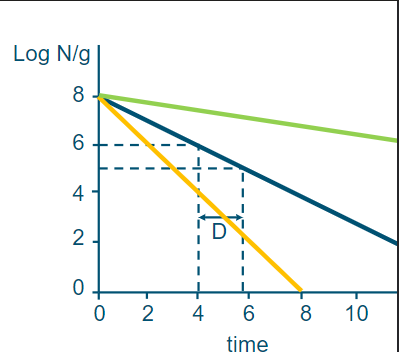
How interaction between microorganisms can cause spoilage of food. (implicit)
Physiological characteristics of microorganisms
They can also influence each other positively/negatively
Negatively: Antagonism:
Some microorganisms produce antimicrobial substances that inhibit the growth of others.
E.g. Lactic acid produces lactic acid which creates an environment that prevents the growth of competing microbes leading to spoilage by the dominant species.
Positively: Synergy
Can promote spoilage by enhancing each other’s surivival
One microbe might produce essential nutrients that another microorganism requires or degrade antimicrobial components, allowing a wider range of spoilage organisms to thrive.
Formula for exponential growth of bacteria
Nt=N0 × 2n
Nt=N0 × 2t/(GT)
Nt = Number of cells at time t
N0= Initial number of cells (t=0)
n = number of generations
GT = generation time
t = time
Formula for concentration of microorganisms
Log (C) = Log (n x 1/d x 1/v)
n= colony count per plate
d= dilution (expressed as 10^-d)
v = volume of diluted sample
Fungi (unicellular)
Unicellular: Yeast
Much bigger than bacteria
Shape is similar to bacteria; has an oval shape.
Multiplies by budding (asexual) or by ascospores (sexual)
Ferment sugars (produces ethanol & CO2)
Fungi (multicellular)
Multicellular: molds
They start growing before you can see them by human eye.
Mold have frets that are branch like structures
Some have septa which are internal cross walls and some don’t have septa.
If you have a lot of branching it is called mycelium.
The scientific term for the fret is hypha
Hypha is 3 micrometers
Forms spores.
The inner part of the mycelium is older and often have darker colors and have more spores.
When you touch the spores they can spread everywhere in the air.
Naming bacteria
Genus, species, strain: Bacillus cereus ATCC 14579
Genus should be written with a capital and in italic, species in italic
ATCC stands for American Type Culture Collection
Classification of bacteria (gram staining)
Gram-positive: will become purple, thick outer layer only has peptidoglycan (polysaccharide)
Survive dry environments better
Gram-negative: will become pink, thin in-between layer of peptidoglycan and has outer membrane.
Are more sensitive
Classification of bacteria (enzyme activity)
Oxidase test (reduce molecular oxygen to yield water and generate energy conservation): If it has oxidase it will become purple
Catalase test (breaks down H2O2): If it has catalase, the solution will bubble
Four scenarios in contamination of microorganisms.
Growth - Occurs when water and nutrients are available, temp and pH are suitable. Very dependent on availability of oxygen.
Inactivation - When microorganisms are in a bad environment e.g. low pH.
Dormany - When they do not grow nor die.
Lethal stimulation - When bacterial spores germinate in a favorable environment in the presence of a poisonous matter for the dividing cells then death will occur.
Growth curve
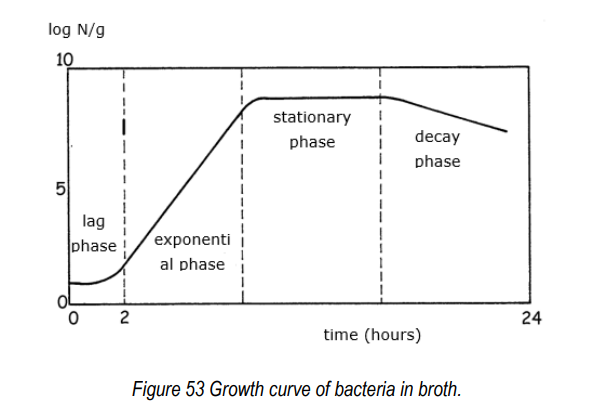
What is generation time?
Generation time (τ or GT) is the average time between two consecutive generations. For microorganisms, the generation time is also called doubling time.
The reason we use log concentrations for microbes concentration
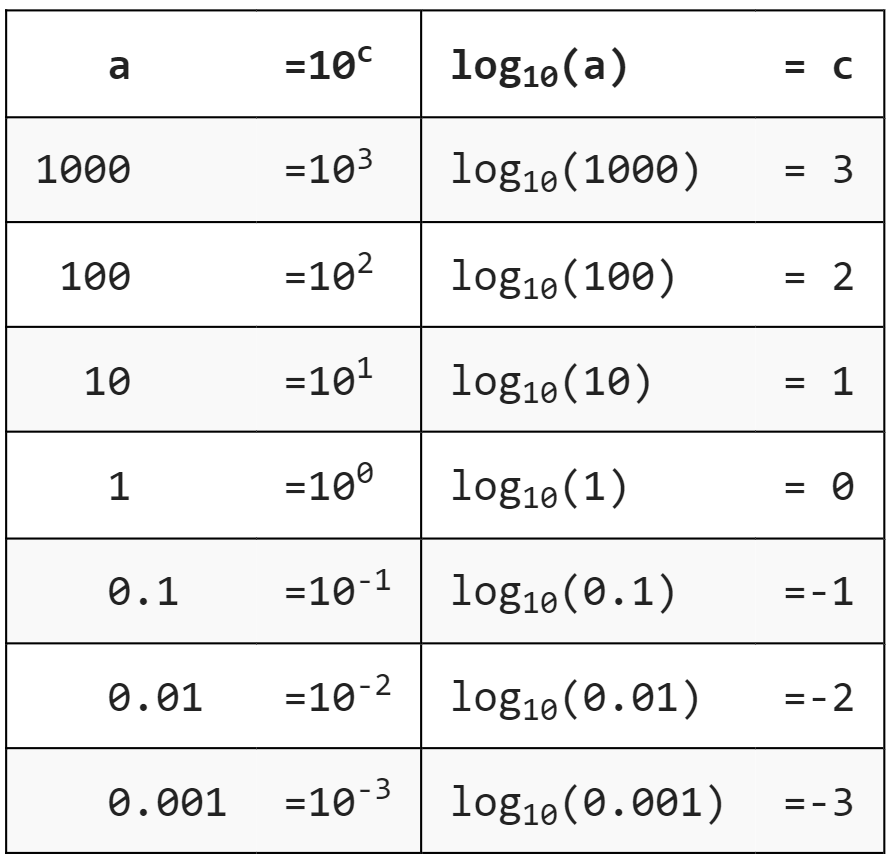
How to find the maximum growth rate
The slope of the exponential growth phase is the maximum growth rate k (log10 h-1)

How to calculate the concentration (log10(C)) at a certain time point in the exponential growth phase (t in hours)
log10(Ct) = log10(C0) + k ∙ t
where log10(C0) is the initial concentration (at t = 0).
How is the maximum growth rate commonly expressed?
on natural logarithmic scale (ln-scale) instead of log10-scale
In that case, the growth rate is referred to as µmax (h-1).
Relation between maximum growth in K vs in µmax

maximum specific growth rate
τ is the doubling time (the time it takes for the population to double in size), usually in hours.

Serial dilutions
The concept of serial dilutions has been introduced to obtain plates with a countable number of colonies. The range between 30 and 300 colonies per plate can be considered as optimal for counting. If the number of colonies is below 30, the estimation of the number of microorganisms in the original food sample will become less accurate. If the number of colonies is above 300, the growth of the colonies will be restricted and the colonies may tend to merge.